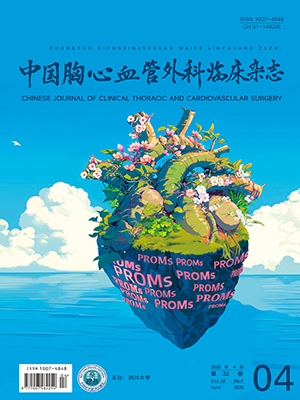Objective To explore the independent risk factors for postoperative retention of urinary catheters in the ward of lung tumor patients due to urinary retention under the concept of enhanced recovery after surgery (ERAS).Methods Seventy-five patients with lung tumors who had urinary catheters left in the postoperative ward between June 2019 and August 2019 were selected as a case group, and 75 patients with lung tumors who did not have urinary catheters in the perioperative period as a control group. Independent risk factors for indwelling urinary catheters in the postoperative ward were screened by univariate and multiple-variate logistic stepwise regression analysis.Results There were 45 males and 30 females in the case group with an average age of 55.33±10.78 years, 28 males and 47 females in the control group with an average age of 57.12±10.06 years. Univariate analysis showed that gender, operative time>2 h, intraoperative fluid volume≥1 200 mL, and fluid volume within 6 h of returning to the ward after surgery>1 200 mL were associated with the occurrence of indwelling urinary catheters in patients with lung tumors in postoperative wards (P<0.05). Multiple-variate logistic regression showed that male (OR=2.311, 95%CI 1.173-4.552, P=0.015), infusion volume within 6 h of returning to the ward after surgery>1 200 mL (OR=2.491, 95%CI 1.149-5.401, P=0.021) and intraoperative infusion volume≥1 200 mL (OR=2.105, 95%CI 1.022-4.340, P=0.044) were independent risk factors for postoperative retention of urinary catheters in patients with lung tumors.Conclusion The occurrence of indwelling urinary catheter in lung tumor patients under the ERAS concept is the result of a combination of factors, and patients who are male, have infusion volume>1 200 mL within 6 h of returning to the ward after surgery, and have intraoperative infusion volume≥1 200mL are the high-risk group for postoperative ward indwelling urinary catheter, and health care personnel should strengthen the assessment and observation, provide targeted health education, appropriately control the perioperative fluid volume, and take other measures to reduce the occurrence of indwelling urinary catheters due to urinary retention postoperatively in ward.
Citation:
ZHANG Na, ZHANG Huanhuan, LI Yushan, YANG Bo, LIU Yan. Risk factors for postoperative retention of urinary catheters in patients with lung tumors under concept of enhanced recovery after surgery: A case-control study. Chinese Journal of Clinical Thoracic and Cardiovascular Surgery, 2021, 28(7): 821-825. doi: 10.7507/1007-4848.202012049
Copy
Copyright © the editorial department of Chinese Journal of Clinical Thoracic and Cardiovascular Surgery of West China Medical Publisher. All rights reserved
| 1. |
Li JS. The definition of fast-track surgery. Zhonghua Yi Xue Za Zhi, 2007, 87(8): 515-517.
|
| 2. |
梅建东, 车国卫, 杨梅, 等. 加速康复外科 (ERAS) 理念开启胸外科新篇章—记第一届胸科 ERAS 华西论坛. 中国胸心血管外科临床杂志, 2017, 24(1): 1-5.
|
| 3. |
苏树伟, 崔海银, 田辉, 等. 肺癌患者胸腔镜肺叶切除术后发生尿潴留的危险因素分析. 山东医药, 2018, 58(6): 74-76.
|
| 4. |
倪瑞婕, 王晓军. 单孔胸腔镜辅助手术术中无尿管留置的应用效果. 国际护理学杂志, 2020, 39(20): 3726-3728.
|
| 5. |
倪瑞婕, 李志新, 王晓军. 胸腔镜肺切除术围术期不放置导尿管的可行性研究. 中国微创外科杂志, 2019, 19(11): 989-992.
|
| 6. |
张娜, 李玉善, 杨波, 等. 胸腔镜肺叶切除术后患者病房留置尿管的危险因素分析. 中国胸心血管外科临床杂志, 2020, 27(7): 789-792.
|
| 7. |
王建华, 袁聚祥, 高晓华. 预防医学. 第 3 版. 北京: 北京大学医学出版社, 2013. 189.
|
| 8. |
邱舫, 杨梅, 车国卫, 等. 胸腔镜肺叶切除术患者围手术期无尿管留置导致尿潴留的危险因素分析. 中国胸心血管外科临床杂志, 2016, 23(4): 328-333.
|
| 9. |
Kim KW, Lee JI, Kim JS, et al. Risk factors for urinary retention following minor thoracic surgery. Interact Cardiovasc Thorac Surg, 2015, 20(4): 486-492.
|
| 10. |
Scott AJ, Mason SE, Langdon AJ, et al. Prospective risk factor analysis for the development of post-operative urinary retention following ambulatory general surgery. World J Surg, 2018, 42(12): 3874-3879.
|
| 11. |
徐燕, 韩啸. 胸腔镜肺叶切除术后患者尿潴留危险因素分析. 浙江医学教育, 2019, 18(3): 41-43.
|
| 12. |
Koch CA, Grinberg GG, Farley DR. Incidence and risk factors for urinary retention after endoscopic hernia repair. Am J Surg, 2006, 191(3): 381-385.
|
| 13. |
史忠波. 静脉输液对肛门病术后尿潴留的影响. 中国肛肠病杂志, 2018, 38(12): 50-52.
|
| 14. |
虞文魁, 李宁. 加速康复外科理念指导下的围手术期液体治疗. 中国实用外科杂志, 2017, 37(4): 342-344.
|
- 1. Li JS. The definition of fast-track surgery. Zhonghua Yi Xue Za Zhi, 2007, 87(8): 515-517.
- 2. 梅建东, 车国卫, 杨梅, 等. 加速康复外科 (ERAS) 理念开启胸外科新篇章—记第一届胸科 ERAS 华西论坛. 中国胸心血管外科临床杂志, 2017, 24(1): 1-5.
- 3. 苏树伟, 崔海银, 田辉, 等. 肺癌患者胸腔镜肺叶切除术后发生尿潴留的危险因素分析. 山东医药, 2018, 58(6): 74-76.
- 4. 倪瑞婕, 王晓军. 单孔胸腔镜辅助手术术中无尿管留置的应用效果. 国际护理学杂志, 2020, 39(20): 3726-3728.
- 5. 倪瑞婕, 李志新, 王晓军. 胸腔镜肺切除术围术期不放置导尿管的可行性研究. 中国微创外科杂志, 2019, 19(11): 989-992.
- 6. 张娜, 李玉善, 杨波, 等. 胸腔镜肺叶切除术后患者病房留置尿管的危险因素分析. 中国胸心血管外科临床杂志, 2020, 27(7): 789-792.
- 7. 王建华, 袁聚祥, 高晓华. 预防医学. 第 3 版. 北京: 北京大学医学出版社, 2013. 189.
- 8. 邱舫, 杨梅, 车国卫, 等. 胸腔镜肺叶切除术患者围手术期无尿管留置导致尿潴留的危险因素分析. 中国胸心血管外科临床杂志, 2016, 23(4): 328-333.
- 9. Kim KW, Lee JI, Kim JS, et al. Risk factors for urinary retention following minor thoracic surgery. Interact Cardiovasc Thorac Surg, 2015, 20(4): 486-492.
- 10. Scott AJ, Mason SE, Langdon AJ, et al. Prospective risk factor analysis for the development of post-operative urinary retention following ambulatory general surgery. World J Surg, 2018, 42(12): 3874-3879.
- 11. 徐燕, 韩啸. 胸腔镜肺叶切除术后患者尿潴留危险因素分析. 浙江医学教育, 2019, 18(3): 41-43.
- 12. Koch CA, Grinberg GG, Farley DR. Incidence and risk factors for urinary retention after endoscopic hernia repair. Am J Surg, 2006, 191(3): 381-385.
- 13. 史忠波. 静脉输液对肛门病术后尿潴留的影响. 中国肛肠病杂志, 2018, 38(12): 50-52.
- 14. 虞文魁, 李宁. 加速康复外科理念指导下的围手术期液体治疗. 中国实用外科杂志, 2017, 37(4): 342-344.




